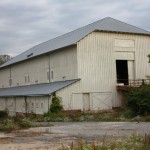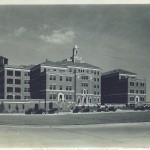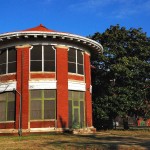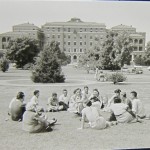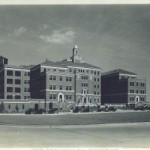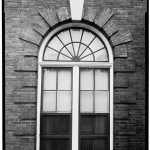History
An historic gem in the middle of the nation’s capital, St Elizabeths East is located at the site of a formerly self-contained mental health community – St Elizabeths Hospital. Once a source of economic stability for neighborhoods east of the Anacostia River, this campus is surrounded by the rich and complex history of communities that are an essential part of the story of the District of Columbia. Its associations with some of America’s most famous people and events, coupled with a once-celebrated past of architectural innovation and landscape design, make it a largely unexplored historic treasure.
East Campus History
Following its 19th century use for agricultural purposes, the East Campus became home to a first group of buildings in 1902. The buildings referred to as the Richardson Group or the 1902 Buildings, were part of the largest expansion in the history of both campuses.
The four two-story red brick buildings built on the East Campus for lack of space on the West Campus followed the same Italian Renaissance Revival styling as the older buildings of the West Campus and are exquisitely detailed with central cupolas, exposed rafter tails, brick chimneys, and rounded columns topped with red tile hipped roofs. These four buildings are referred to in campus references as R Building (Building 89), I Building (Building 95), N Building (Building 94), and P Building (Building 100).
The next significant East Campus development came in the 1930s with the construction of the larger buildings around Maple Square which would house the acute physical and mental treatment centers for the hospital. Their construction represents the shift to the scientific treatment of patients in the field and the move toward training interns at St Elizabeths Hospital. These buildings maintained the Italian Renaissance Revival style with their red brick and red tile roofs of the 1902 buildings, but on much larger structures.
While the scientific buildings were being developed at Maple Square, a new complex of patient residences was also being built southeast of the Richardson Group. Called the Continuous Treatment (CT) buildings, they were designed in the new cottage form and comprised six two-story residential structures (Buildings 106, 107, 108, 110, 111, and 112) surrounding a central kitchen and cafeteria (Building 109). All the buildings were connected to the cafeteria by two-story covered brick walkways. This complex continued the Italian Renaissance Revival style of the rest of the campus, with red brick and hipped red tile roofs, but fewer decorative details.
The final phase of East Campus construction (excluding the most recent facility, built on the far Eastern parcel of the East Campus) came in the 1950s and early 1960s. Three large institutional buildings were built in the East Campus study area after 1940: Building 119 in 1952, Building 122 in 1959, and Building 124 in 1963.
Hospital History
Organized by Congress in 1855 as the Government Hospital for the Insane, the institution that would become a nationally recognized symbol of healthcare and medical breakthroughs became known as St Elizabeths during the Civil War. Wounded soldiers treated here were reluctant to admit that they were housed in an insane asylum, and instead referred to their location as “St Elizabeths.”
St Elizabeths had been the name given to the original 600-acre tract of land by a 17th century owner, John Charman IV. The curious absence of an apostrophe in “Elizabeths” dates to a time when the use of such punctuation was inconsistent at best. Congress officially changed the name to St Elizabeths Hospital in 1916.
The hospital’s early mission, as defined by the famed social reformer Dorothea Lynde Dix, was to provide the “most humane care and enlightened curative treatment of the insane of the Army, Navy, and District of Columbia.” Dix, a devoted advocate for the mentally ill, and Dr. Charles Henry Nichols, a physician who specialized in the treatment of mental illness, persuaded Congress to purchase the original 189 acres and fund the hospital.
St Elizabeths Hospital purchased the East Campus in 1869 to expand the agricultural activities that were considered essential to both the mission and the economy of the renowned institution. Until the 20th century, the barns, stables, henneries, and piggeries that contributed to the hospital’s food production were jumbled with staff cottages throughout the pasture land. After the end of the 19th century, the East Campus was gradually converted from farm to facilities for an increasingly larger patient and staff population.
St Elizabeths was a prominent example of the mid-19th century movement advocating moral treatment of the mentally ill through a therapeutic combination of architecture and the natural environment. Perhaps the most famous institution of its kind in the U.S., St Elizabeths Hospital was one of the first hospitals to care for injured African American soldiers during the Civil War. It was home to one of the country’s earliest psychiatric facilities (Howard Hall, 1887), built specifically to care for and treat the criminal insane and mentally ill offenders. And it pioneered the use of hydrotherapy, psychodrama, and pets as a part of therapy.
By the 1940s, the first and only federal mental facility with a national scope housed 7,000 patients and sprawled across more than 350 acres on both the west and east sides of Nichols Avenue (formerly Asylum Avenue and now Martin Luther King Jr. Avenue SE). Setting the stage for the contemporary vision for St Elizabeths East, the East Campus became the hospital’s center of scientific research and medical services in the 1920s.
Coinciding with the federal deregulation of mental healthcare, the 183-acre St Elizabeths East campus was transferred to the District in 1987 . In subsequent years, mental health facilities were concentrated in buildings on the eastern end of the campus, and in April 2010, a new hospital opened to continue to serve local patients and federally assigned inmates with mental health concerns.
St Elizabeths was designated a National Historic Landmark in 1990. The East Campus is also a designated historic district in the District of Columbia Inventory of Historic Sites (2006).


